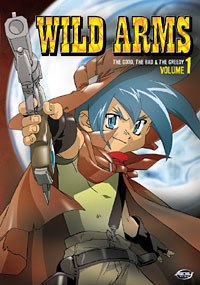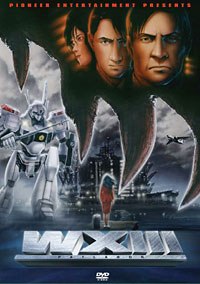Mark Simon continues his series of twelve excerpts from his new book Producing Independent 2D Character Animation: Making and Selling a Short Film. Every independent needs helpthis month Mark runs down ways to obtain a crew that wont just help, but excel.
Around 1995, Japanese animation (anime) began pouring into North America, Europe and across the globe in video form. Most of these titles were unknown outside of Japan and never covered by animation journals. Whether a title is highly popular or very obscure, a high-quality theatrical feature or a cheap and unimaginative direct-to-video release, they all look the same on a store shelf. Therefore, Animation World Magazine will regularly review several new releases (including re-releases not previously covered) that have merit.

Betterman. V.1, The Awakening. V.2, Metamorphosis. V.3, Seeds of Death. V.4, Inhuman Nature. V.5, Despair. V.6, Finality.
TV series (26 episodes), 1999. Director: Yoshitomo Yonetani. V.1-2, 5 episodes/125 minutes; v.3-6, 4 episodes/100 minutes. Price & format: DVD bilingual $29.98. Distributor: Bandai Entertainment.
Betterman (inconsistently sometimes spelled Better Man) is a mix of two stereotyped dramatic anime TV s-f serial plots; the small team of scientists and action field agents who must race to identify an unknown but seemingly invincible threat before it can destroy the world, and the tragic hero who has been turned into a hideous monster, yet loyally uses his new powers to protect the humanity from which he is now estranged. The 26-episode Betterman (broadcast on Japanese TV from April 1 through September 30, 1999) presumably had a low budget since the animation is unusually limited for the Sunrise studio's standards.
"It's like we're in some cheap monster movie!" the teen protagonist screams in episode 10, summing it up nicely. Keita Aono, a 17-year-old video-game junkie, is eagerly awaiting the grand opening of the Bottom World underground amusement park when some disaster destroys it, killing more than 200. In the chaos Keita crawls for protection into what he thinks is a dummy giant robot and accidentally activates it. From inside the robot he watches the park's giant mechanical clowns try to kill people, who are saved by a frightening sharklike monster. Keita has seen things that the government is trying to keep from the public. He also has the ability to control the mechanical "neuronoid" suit by his psychic energy, which is almost unheard of. So he is drafted into Akamatsu Industries' research team, which invented the neuronoid mobile suits, originally intended for dangerous labor, but now pressed into service to fight the menace codenamed "Algernon." The first 10 episodes gradually introduce Keita (and the audience) to his varied but likeable teammates while battling individual horror-moviesque Algernon-caused disasters, most of which are stopped by Betterman. Episodes 11-14 are a four-part struggle against what seems to be the main villain, but who turns out to be only a pawn of Algernon. From episodes 15 on, the attacks focus upon Keita and his friends. The mood quickly turns from comedic parodies of horror movies to grim despair as Keita sees his new friends driven mad or killed, one by one. Clues to the secrets behind Algernon and Betterman are revealed with frustrating slowness.
The main difference between Betterman and other sci-fi anime serials using this formula is that the pseudo-scientific babble is centered around organic biochemistry rather than mechanical technology, such as amino acids, brain implants, telomeres, using pheromones to direct waves of attacking insects, controlled biological mutation, misusing cancer research into controlling cellular division to deliberately create monsters and so on. Unfortunately, the plot suffers from too many secrets within secrets, establishing an impression that the heroes are not so much intelligently advancing toward the solution as that the scriptwriters are jerking them around on phony side-adventures until it is time for the serial to reach its final episode.

Fist of the North Star: The Series. V.1-V.5.
TV series (36 episodes), 1984-1985. Director: Toyoo Ashida. V.1-v.4, 7 episodes/210 minutes; v.5, 8 episodes/240 minutes. Price & format: DVD bilingual $29.95. Distributor: Manga Entertainment.
Hokuto no Ken (the title is a pun: "Ken" means "fist" but it is also the nickname of the hero, Kenshiro) was one of the legendary anime TV series of the 1980s, produced and animated by Toei Doga, adapted from the popular manga by Bronson and Tetsuo Hara. It ran for 109 episodes from October 4, 1984 through March 6, 1987, and was immediately followed by Hokuto no Ken 2 for episodes #110 through #152 (March 12, 1987 - February 18, 1988). Manga Entertainment's DVD release includes only the first 36 episodes, comprising the first story arc.
Fist of the North Star is one of those rare works which successfully idolizes yet simultaneously parodies a stereotype; the gory-yet-sanitized violence of martial-arts video games beloved by adolescent males, focused through an exaggeration of The Road Warrior and Bruce Lee movies. The futuristic "199X" is a post-nuclear war parched planet of dried-up oceans, ruined cities and starving, ragged survivors who are preyed upon by sadistic, hulking punk-tattooed bikers who seemingly have no trouble finding unlimited fuel for their road hogs. Their savior is Kenshiro, master of the North Star school of martial arts, identified by the seven scars symbolizing the Big Dipper punched into his brawny chest by his enemy Shin. Ken and Shin were rivals for leadership of the North Star school; but when Shin was rejected because he refused to use his powers only for good, he kidnapped Ken's fiancée Julia and fled to establish the bloody Southern Cross world-conquering empire. Now Ken wanders the blasted Earth seeking to rescue Julia, stopping at a new town each week to free it from a bullying biker gang, a rogue commando team from the old government's army trying to set itself up as new feudal overlords, a bloodthirsty religious cult, giant mutants or the vanguards of Shin's troops. Particularly difficult adversaries might take three episodes to defeat.
Testosterone-hyped teen males can't get enough of each episode's stereotyped confrontation. Ken is surrounded by sadistically giggling bullies twice his size, licking their knives. Ken calmly cracks his knuckles and growls, "You're already dead!" then launches himself into the air in a super-karate attack. The villains' heads explode or their bodies collapse into sliced pieces, while their blood fountains out in a glittery pastel psychedelic light show rather than nauseating gore. It became a challenge among animators and fans to see how many different tastefully artistic ways Ken could be shown slaughtering his foes. Episode titles like "The Deadly Fist of Lingering Regret! The Future is Sighted in the Barren Desert!" and "The Raging Flame Reverse Flow Punch! There are Too Many Who Must Die!!" similarly both set up and parody this over-the-top martial-arts atmosphere. Duplicating cartoonist Hara's realistic art style for a weekly TV series forced Director Ashida to bring limited animation to new levels of dramatically held poses and tension developed through dialogue and good voice acting, especially during these first 36 episodes when Toei's animation team was fresh and enthusiastic.
His and Her Circumstances. V.1, The Appearance of a Normal Life. V.2, Love and War Under the Cherry Blossoms. V.3, Another Life, Less Ordinary. V.4, Formulation of Truth and Sentiment. V.5, title not yet determined. TV series (26 episodes), 1998-1999. Director: Hideaki Anno. V.1, 6 episodes/180 minutes; v.2-5, 5 episodes/150 minutes. Price & format: DVD bilingual + Spanish subtitles $29.95. Distributor: The Right Stuf International.
Usually limited animation is a detriment, but His and Her Circumstances could be a case study of what a brilliant writer-director (Anno was the creator of Evangelion) can do with limited animation; not to mention scripting a delightful first-love story. 15-year-old Yukino Miyazawa is accustomed to being the darling of her elementary and middle schools, popular with teachers and classmates. She really has an obsession with public approval. Now entering high school, she finds herself mixing with the top students of other lower schools; notably Souichirou Arima, her male counterpart as polite, friendly, and #1 on all tests. Also, all the girls who used to accept Yukino as their social leader are now flocking around the handsome Arima. He, in turn, is talented but has little drive; he has allowed himself to be passively molded by his parents and teachers. Yukino at first plans to sabotage Arima's popularity, but she is smart enough to realize her own pettiness and how she has built her goals on a childish ego; while Arima watches her dynamic personality and realizes his own lack of goals. His and Her Circumstances (26 TV episodes broadcast from October 2, 1998 through March 26, 1999; animated by the Gainax and J.C. Staff studios) is the story of two youths realizing that they are maturing from childhood, beginning to choose their own friends and search for goals for their adult lives, and trying to analyze their new feelings ("How do we know whether this is just our adolescent hormones stirring, or real love?").
Making the protagonists intelligent and introspective allows for long stretches of artistic but extremely limited animation; thought-voices over an imaginative variety of thoughtful facial closeups and background scenery of greeting-card prettiness. This is intercut with frenetic but cartoony scenes of Yukino's rambunctous home life with two younger sisters, or "raw Id" wish-fulfillment images of what Yukino would like to do if she were not so well-bred. Some sequences are shown as motionless comic book panels. A lengthy sequence telling how Yukino's parents met and wed is shown in the form of a 1950s TV kinoscope; black-&-white and grainy. The visual atmosphere is enhanced by clever use of a music library; Beethoven and other classics plus long, dreamy piano solos for the introspective scenes, and lively pop music (movie and TV themes, pop hits; the lively dinnertimes at Yukino's home always have a background of Herb Alpert's Tijuana Brass) for the action scenes. His and Her Circumstances is a realistic adolescent girls' romance story without any of the zany fantasy that is usually needed to attract teen viewers; but it has enough charm and soul, and enough witty zest in its visual presentation to have made it a favorite with anime fans in Japan and America.

Wild Arms. V.1, The Good, the Bad & the Greedy. V.2, Western Romance. V.3, The Return of Laila. V.4, Lie, Cheat & Steal. V.5, Sheyenne's Last Stand.
TV series (22 episodes), 1999-2000. Director: Itsuru Kawasaki. V.1 & v.5, 5 episodes/125 minutes; v.2-4, 4 episodes/100 minutes. Price & format: DVD bilingual $29.98. Distributor: A.D.V. Films.
Wild Arms (age-rated 12+) looks like an anime parody of spaghetti Westerns for the Pokémon set, but it has enough adolescent humor to make it enjoyable for teens. Wild Arms is a popular Japanese video game series; this 22-episode TV serialization (October 18, 1999 through March 27, 2000, animated by the Bee Train studio) was called Wild Arms: Twilight Venom, with the subtitle deliberately chosen to be abbreviated Wild Arms TV.
The story begins in mid-action on a fantasy world mixing a 19th century cowboy culture with futuristic weapons technology, where humans and Pokémon-type cute small "monsters" are social equals. A sadistic warden at an escape-proof prison is torturing a brawny adventurer-type addressed as Dr. Kiel Aronnax. Three female thieves (human adult femme fatale Loretta Oratorio, "human" (actually a vampire) juvenile tomboy Mirabelle Graceland, and tiny furry harridan Jerusha) break in to steal an unknown "top secret treasure." Kiel, freed in the confusion, helps the women unlock the treasure, which turns out to be an apparent 10-year-old boy in suspended animation. The boy, when revived, claims to be legendary adult gunslinger Sheyenne Rainstorm, believed to have been killed years earlier. Apparently the government (an oppressive tyranny, which justifies rebelling against it) has faked Sheyenne's death and transferred his mind to a juvenile android body.
This sets up the individual picaresque adventures from episodes #2 on. The main P.O.V. is Sheyenne (the Japanese misspelling of Cheyenne is fixed through numerous wanted posters in the background art), an impulsive adult ego frustratingly trapped in a preadolescent's body. Beautiful women who used to lust after him now treat him like a cute kid brother. He has psychic control over special ARMS weapons which only he can shoot, but his body is now too small to handle the recoil. Sheyenne, accompanied by Kiel and Isaac (a male counterpart of Jerusha), wanders from Western town to town following up on rumors of "hidden treasures" which may be his real body. The women follow, hoping the treasures are of the more negotiable kind. As usual with anime TV serials, the story slowly grows more dramatic. It is not until episode #11 that the viewer is prompted to wonder about Kiel (why is he sticking with Sheyenne, why was he in prison, what kind of "Doctor" is he); about the government's motive for getting rid of Sheyenne without killing him; and other questions which establish that Wild Arms does have an ongoing plot, after all.
Many episodes are parodies of Western movie stereotypes, mildly risqué enough to belie the Pokémon art style. Two legendary lovers turn out to have been homosexuals. Loretta loses all her money gambling and announces that she is forced to "sell her body;" after milking this for lewd innuendo, it turns out that she has entered a women's mud-wrestling bout. The music (by Kow Otani) is a great pastiche of spaghetti Western composer Ennio Morricone's style. Wild Arms is light, tongue-in-cheek fun.

WXIII: Patlabor the Movie 3.
Theatrical feature, 2002. Director: Fumihiko Takayama. 102 minutes. Price & format: DVD bilingual $24.98/special edition with extras $59.98. Distributor: Pioneer Entertainment.
WXIII: Patlabor the Movie 3 (a.k.a. Patlabor 3: WXIII, Patlabor WXIII the Movie and Patlabor: Wasted Thirteen) is an enjoyable animated theatrical sci-fi/horror thriller in the Godzilla genre. However, it exemplifies some of the problems of theatrical movies made to capitalize on old TV series. Mobile Police Patlabor (based on a manga by Masami Yuki) actually achieved its popularity through two direct-to-video series, a year-long TV series, and two theatrical features between 1988 and 1994, all early works of noted anime director Mamoru Oshii animated by the Headgear and Sunrise studios. Set 10 years in the future, Patlabor brought the giant robot genre into a relatively realistic setting by using them as heavy-duty "labor" vehicles for military, industrial and police work. The focus was upon the latter, specifically the misadventures of the Tokyo Police Force's Pat(rol) Labor Division 2 while trying to do their jobs in giant robots instead of patrol cars. The mecha immediately took a back seat to the fully-characterized human cast: enthusiastic rookie Noa Izumi, sleepy-looking but sharp-witted Captain Goto, excitable and trigger-happy Officer Ota, plus about 10 others. Many episodes dispensed with the mecha altogether in favor of developing the friendships, loves, rivalries and personal problems of the team. Plots deliberately varied wildly. The audience never knew whether the next episode would be serious or a comedy, a realistic dramatization of police action or a human-interest episode in one of Labor Division 2's member's lives or a fantasy-parody of a classic Japanese monster movie.

Ten years later. How to bring back Patlabor for the big screen in a way to please both old fans and new viewers unfamiliar with the old cast? It was decided to create a "side story" in which Labor Division 2 is in the background. WXIII: Patlabor the Movie 3 (animated by the Madhouse studio, released March 30, 2002) is set in a near future in which a controversial land reclamation project is filling in part of Tokyo Bay. Deadly disasters begin happening to the project's Labor machines and their operators. Police detectives Takeshi Kusumi (old veteran) and Shinichiro Hata (rookie) initially suspect sabotage by protestors, but clues to a recent cargo plane crash in the Bay and a governmental top-level coverup of what the plane was carrying lead them at first reluctantly but with growing conviction to a more fantastic conclusion. This is confirmed about half way through the movie when the monster fully emerges. The original Labor Division 2 cast appears only for the lengthy climax, called in to support Kusumi and Hata in their trap for the monster. Madhouse's theatrical animation quality is fine, and the story is a plausibly-developed techno-thriller blending conspiracy coverups (what government agency or megacorporation created the monster, and how far can it go to suppress the fact?) with fast-paced police vs. monster action scenes. Patlabor fans were disappointed that there was so little of Patlabor in it, which may be a benefit for viewers unfamiliar with the series. Pioneer is offering this in both a DVD of just the movie, and a three-DVD boxed set with 220 minutes of extras.
Fred Patten has written on anime for fan and professional magazines since the late 1970s. He wrote the liner notes for Rhino Entertainment's The Best of Anime music CD (1998), and was a contributor to The World Encyclopedia of Cartoons, 2nd Edition, ed. by Maurice Horn (1999) and Animation in Asia and the Pacific, ed. by John A. Lent (2001).








